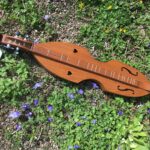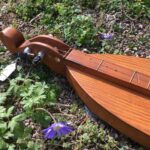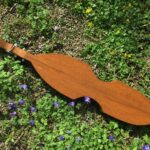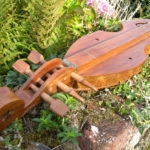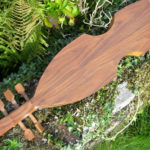Bill Davis “Church” or “Fiddleside” Dulcimers
William Barney “Bill” Davis (1926-1995) was born and died in Benton County, Tennessee. He was a Navy veteran, a plumber who had his own plumbing business, a folk musician and a dulcimer luthier. Bill saw his first dulcimer in 1956 and started building them around 1961. In 1963, he and his then wife, Jean Davis (Schilling) went full time in the luthier business opening the Davis Dulcimer Shop in Gatlinburg, TN. In 1968, his four string dulcimers sold for $100 and about $150 in 1971. Davis experimented with a number of different patterns before settling on his now-iconic “Church” or “Fiddleside” dulcimer. He built more than 1,000 finished dulcimers and another 1,400 (estimated) kits, most of which have elegantly carved headstocks and all of which have wooden pegs. Their son, Jack Davis, also builds dulcimers and bowed psalteries. Bill released a number of LPs featuring he and/or Jean performing regional dulcimer music. He apprenticed the luthier Sam Carrell for a short period in 1974/75. Sam later moved to Townsend, TN and made dulcimers in a similar style under his own name – he claimed to have built between 1300 and 1500. Sam in turn mentored Mike Clemmer who continues to make a modern version of the “fiddleside” dulcimer in Tennessee. Bill apparently had drink-related problems in the 1970s and his building career ended after he lost some fingers to a table saw.
Bill and Jean organized a number of dulcimer-related festivals in Gatlinburg, Pigeon Forge and elsewhere in the Tennessee Smoky Mountains through the 1960s and 1970s, promoting mountain dulcimers and traditional music, and performed regularly on the local Gatlinburg TV.
As mentioned, many of these dulcimers were sold, more as kits than finished by Davis himself. The ones built by Davis are usually signed on the back, on the lower bout through the varnish. They also tend to have better quality woods and/or more elaborate decoration on the headstock.
[Thanks to David Bennett and personal correspondence with Sam Carrell for most of this info.]
3.100 Late 1960s/early 70s Davis-style ‘church’ or ‘fiddleside’ dulcimer, 5 string, 4 course £350 + NEW robust padded soft case if required £25
No label but very reminiscent of Davis design and construction, possibly a kit? Made entirely of wormy chestnut, giving it a slightly straw or ochre colouring and making it, more importantly, very light. A bookmatched, largely hole-free back; bookmatched sides; bookmatched top with plentiful holes and an f-hole (LB)/hearts (UB) soundhole design. Tapered wormy scroll (not typical of Davis, though similar scale) and pegbox, with un-typical wooden peg design. Scroll and pegbox are integral and may be a laminate of two pieces of matching chestnut for added strength. Now fitted with planetary (geared) De Jung chrome tuners with black buttons (the original three of five wooden pegs have been preserved). Internally, two large transverse struts across the wide back. Brass frets on hollow chestnut fingerboard, which also has holes, even on the playing surface! Typical Davis-style, triangular section hardwood nut and bridge, originally showing a 4 equidistant course set-up, with doubled melody string (5 in total). Has now been adjusted for a more conventional 3 course, 3 or 4 string arrangement. Bridge was glued in place when, if a Davis kit, it should have been floating (i.e. movable). Small brass mushroom-headed pins as string anchors; hardwood cross-grain block at top of tail acting as a strainer, easing the passage of the strings on their way to the bridge and protecting the softer chestnut from damage. Construction is generally good and the whole instrument is solid, although the fretting seems a little untidy.
Overall length 37½”, upper bout 7½”, lower bout 7¼”, depth 1¾, FBW 1½”, VSL 28¼ (long/medium scale), weight 1lb 14oz (847g), strings now 12/[12], 14, 25w. Originally no 6+ fret, now added.
Stunningly light body for such a big instrument (even lighter with original wooden pegs), which makes it a loudish instrument with a bright rather than mellow tone. The volume of body, allied to its shallowness, gives a well-balanced sound with clearly articulated notes. The bridge needed major re-location and, despite the original fretting, the intonation in DAD is now surprisingly good, though goes out rapidly after the 10th fret. The action has been adjusted and, although on the high side, is well within acceptable easy playing limits.
Click on images below to enlarge.
Davis Fiddle-Shaped £Sold
Solid walnut body, with nice figuring throughout. Rosewood cap on endblock to prevent damage to softer walnut; stainless screws as string anchor. One piece walnut fingerboard, hollowed out inside for extra volume. F-hole design with triangular centre for soundholes in lower bout, simple pair of circular holes in upper bout. Overall length 39”, upper bout 7”, lower bout 7¼”, shallow body 1½”, FBW 1½”, VSL 28″ (medium/long scale), weight 2lb 7oz or 1114g. No 6½ fret.

